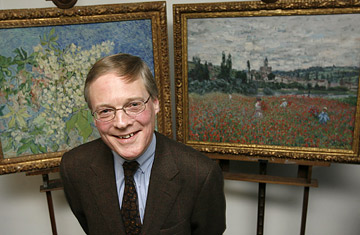
Stolen art? I know it when I see it. Museum director Lukas Gloor is reunited with two recovered paintings in Zurich, Switzerland.
Two of the four paintings stolen at gunpoint earlier this month from a Zurich museum were found in good condition Monday afternoon, the police reported on Tuesday. But efforts continue to catch the thieves and find the other two stolen masterpieces.
Monet's Poppies near Vétheuil and van Gogh's Blossoming Chestnut Branches were found in a parking lot of a Zurich psychiatric hospital. The two other looted paintings, Cezanne's The Boy in the Red Vest and Degas' Count Lepic and His Daughters, are still missing.
The police did not say whether any ransom has been demanded or paid.
"The paintings are in perfect condition, still in their protective glass casing," says the museum's curator Lukas Gloor, who speculates that the thieves abandoned the two larger paintings because they were too cumbersome to transport.
While the police has been investigating tips from around the world, a parking attendant at the Burghölzli, Zurich University's psychiatric clinic located less than a mile from the museum, spotted the two paintings in the back seat of an unlocked white Opel Omega sedan with what police say are stolen license plates.
The police immediately sealed off the immediate area surrounding the hospital. The car was examined by forensic experts before being towed away and impounded.
"The task force is continuing to investigate the theft together with cantonal police and the Federal Criminal Police," Zurich police spokesman Marco Cortesi said in a statement. "Links with other art thefts both in Switzerland and abroad are being looked into."
Neither police nor the museum's management said whether the 56-year-old parking attendant, who stumbled upon the looted paintings during a routine patrol, will receive any of the $90,000 reward that the museum had offered for information leading to the paintings' recovery.
The brazen heist, which the police called the "most spectacular" in Swiss history, took place at 4:30 on the afternoon of February 10, while 15 visitors strolled around three floors of the vine-covered villa, which houses one of the world's most impressive private collections of European art. The masked thieves, including one who witnesses said spoke German with a Slavic accent, ordered the museum staff at gunpoint to lie down on the floor. They then stripped the wall of the downstairs salon of four paintings, estimated at $160 million. The heist took less than three minutes and nobody was hurt.
"The choice of the paintings was probably a combination of premeditation and randomness," Gloor says. "We now believe the thieves targeted the downstairs salon intentionally because that's where our most valuable masterpieces are. But then they randomly picked four paintings that hang in a row."
Gloor says his museum's security measures are being "looked into." Meanwhile, fearing "copycat thefts," the museum decided to close its doors to the public for an undetermined period of time, though carefully screened and chaperoned group visits can still be arranged.
The museum's late founder, German-born industrialist Emil Georg Bührle, made his fortune selling weapons to Germany during WWII. He studied art history and was 30 years old when he began amassing his collection, but his holdings have proven controversial. At least 13 of the artworks he owned at war's end were included on British specialist Douglas Cooper's "looted art list," which was used to recover pieces stolen from Jews by the Nazis. A five-year study undertaken by the Swiss government determined in 2001 that Bührle, who died in 1956, had acquired "flight art" — works smuggled out of Axis-controlled areas and sold at rock-bottom prices.
A report on Swiss TV last week suggested that both the Cezanne and Monet paintings were part of the art confiscated by the Nazis, but Gloor denies the allegations, pointing out that Bührle purchased the works from "longtime collectors."
